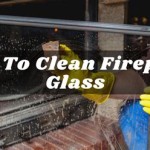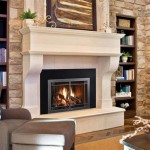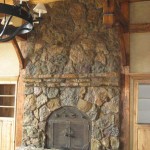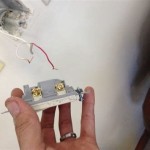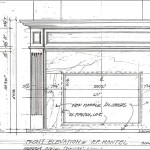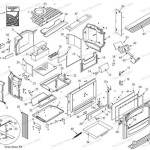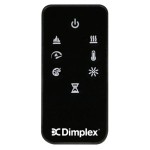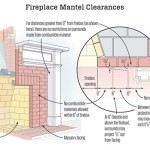Direct Vent Gas Fireplace Insert with Blower: A Comprehensive Overview
A direct vent gas fireplace insert with a blower represents a significant upgrade to traditional wood-burning fireplaces, providing homeowners with a convenient, efficient, and aesthetically pleasing heating solution. This type of fireplace insert transforms an existing masonry or prefabricated fireplace into a zone heating appliance, offering improved efficiency and safety compared to its wood-burning counterpart. The inclusion of a blower further enhances its ability to distribute heat effectively throughout the room.
Direct vent technology is a key feature of these inserts. Unlike traditional fireplaces that rely on the chimney for ventilation and combustion air, a direct vent system utilizes a sealed combustion chamber. This system pulls combustion air from outside the home through a dedicated vent pipe, and exhausts combustion gases directly back outside through a separate, usually coaxial, vent pipe. This eliminates the need for room air to fuel the fire, preventing drafts and reducing the potential for carbon monoxide to enter the living space. The sealed combustion chamber also promotes more complete combustion, resulting in higher efficiency and reduced emissions.
The integration of a blower, also known as a fan, further optimizes the performance of the direct vent gas fireplace insert. The blower circulates the heated air produced by the fireplace, pushing it out into the room more forcefully and evenly. This forced-air circulation significantly improves the fireplace's ability to heat a larger area compared to a radiant heat source alone. The blower is typically electrically powered and controlled by a thermostat, allowing users to adjust the fan speed and maintain a consistent temperature.
Key Benefits of a Direct Vent Gas Fireplace Insert with Blower
Direct vent gas fireplace inserts with blowers offer a wide range of advantages that make them a desirable choice for homeowners seeking an efficient and convenient heating solution. The following core benefits highlight the reasons for their increasing popularity:
Improved Energy Efficiency: Traditional wood-burning fireplaces are notoriously inefficient, often drawing warm air from the house and sending it up the chimney. In contrast, direct vent gas fireplace inserts are significantly more efficient, typically boasting efficiency ratings between 70% and 85%. This higher efficiency is due to the sealed combustion chamber, which prevents heat loss up the chimney, and the use of natural gas or propane as a fuel source, which burns cleaner and more completely than wood. The blower further enhances efficiency by distributing the heat more effectively, reducing the need for supplemental heating.
Enhanced Safety: Direct vent gas fireplace inserts offer a safer alternative to wood-burning fireplaces. The sealed combustion chamber eliminates the risk of carbon monoxide poisoning, a significant concern with traditional fireplaces. Additionally, the absence of open flames and sparks reduces the risk of house fires. The direct vent system also prevents backdrafting, which can occur when a fireplace draws air from inside the house, potentially pulling harmful combustion gases into the living space. These safety features provide homeowners with peace of mind, especially in homes with children or pets.
Convenience and Ease of Use: Unlike wood-burning fireplaces that require manual loading of wood, starting a fire, and cleaning up ashes, direct vent gas fireplace inserts offer unparalleled convenience. They can be easily ignited with the flick of a switch or the push of a button, and they require minimal maintenance. Many models come with remote controls that allow users to adjust the flame height, temperature, and blower speed from the comfort of their couch. The absence of wood storage, chopping, and cleanup also makes them a more practical option for homeowners with busy lifestyles.
Installation and Venting Requirements
Proper installation is crucial for the safe and efficient operation of a direct vent gas fireplace insert with a blower. It is highly recommended to hire a qualified and licensed professional for the installation process. The installation typically involves the following steps:
Inspection of Existing Fireplace: The existing fireplace must be inspected to ensure that it is structurally sound and meets the requirements for installing a gas fireplace insert. This includes checking the chimney for cracks or damage and ensuring that the fireplace opening is the correct size for the chosen insert.
Venting Installation: The direct vent system requires the installation of two vent pipes: one for intake air and one for exhaust gases. These pipes are typically routed through the existing chimney or through an exterior wall. The venting system must be installed according to the manufacturer's specifications and local building codes. Proper venting is essential for the safe and efficient operation of the fireplace insert.
Gas Line Connection: A gas line must be connected to the fireplace insert to provide the fuel source. This connection should be performed by a qualified gas fitter to ensure that it is leak-proof and meets all safety regulations.
Electrical Connection: The blower requires an electrical connection to power the fan. This connection should be made by a qualified electrician to ensure that it is properly grounded and meets all electrical codes.
Testing and Calibration: After the installation is complete, the fireplace insert should be tested to ensure that it is functioning correctly. This includes checking the flame height, blower speed, and venting system. The fireplace insert should also be calibrated to ensure that it is operating at its optimal efficiency.
Features and Options
Direct vent gas fireplace inserts with blowers are available with a wide range of features and options that allow homeowners to customize their fireplace to their specific needs and preferences. Some of the most common features and options include:
Flame Height Adjustment: Many models allow users to adjust the flame height to control the heat output and create different aesthetic effects.
Thermostat Control: A thermostat allows users to maintain a consistent temperature in the room by automatically adjusting the flame height and blower speed.
Remote Control: A remote control provides convenient control over the fireplace insert from anywhere in the room.
Decorative Fronts and Surrounds: A wide variety of decorative fronts and surrounds are available to match the décor of the room.
Log Sets: Realistic log sets create the look and feel of a traditional wood-burning fireplace.
Glass Media: Some models offer glass media as an alternative to log sets, creating a more modern and contemporary look.
Safety Features: Safety features such as automatic shut-off valves and overheat protection ensure safe operation.
Maintenance and Care
To ensure the longevity and optimal performance of a direct vent gas fireplace insert with a blower, regular maintenance and care are essential. Here are some key maintenance tasks:
Annual Inspection: A qualified technician should inspect the fireplace insert annually to check for any potential problems, such as gas leaks, vent blockages, or worn-out parts.
Cleaning: The glass front of the fireplace insert should be cleaned regularly to remove any soot or debris. The interior of the fireplace insert should also be cleaned periodically to remove any dust or dirt.
Venting System Inspection: The venting system should be inspected regularly to ensure that it is free of obstructions and in good working order. This is especially important for systems that vent through the chimney, as debris can accumulate over time.
Blower Maintenance: The blower motor should be lubricated periodically to ensure smooth and quiet operation. The blower fan should also be cleaned to remove any dust or debris.
Gas Line Inspection: The gas line connection should be inspected regularly for leaks. If any leaks are detected, they should be repaired immediately by a qualified gas fitter.
Factors to Consider When Choosing a Model
Selecting the right direct vent gas fireplace insert with a blower requires careful consideration of several factors to ensure a satisfactory heating and aesthetic outcome. Paying attention to these aspects will help homeowners make an informed decision.
Heating Capacity: Determine the square footage of the area needing to be heated and select an insert with an appropriate BTU (British Thermal Unit) rating. An undersized unit will struggle to heat the space effectively, while an oversized unit may cycle on and off frequently, leading to uneven heating.
Venting Options: Assess the existing chimney or the possibility of venting through an exterior wall. Different models have varying venting requirements, so choose one that aligns with the home's structure and local building codes.
Aesthetics and Design: Consider the style and décor of the room where the insert will be installed. Choose a model with a decorative front, log set, or glass media that complements the existing interior design. Available finishes, such as black, brushed nickel, or bronze, can also influence the overall look.
Features and Functionality: Evaluate the desired features, such as remote control operation, thermostat control, flame height adjustment, and the presence of safety features. Determine which features are essential and which are simply nice to have.
Budget: Set a realistic budget for the purchase and installation of the fireplace insert. Prices can vary significantly depending on the size, features, and brand. Obtain quotes from multiple installers to ensure a competitive price.
Direct Vent vs. Vent-Free Gas Fireplace Inserts
When choosing a gas fireplace insert, homeowners often face the decision between direct vent and vent-free models. While both offer advantages over traditional wood-burning fireplaces, they operate on different principles and have distinct characteristics.
Direct Vent: As previously discussed, direct vent inserts utilize a sealed combustion chamber and draw combustion air from outside the home, exhausting gases directly outdoors. This system ensures complete combustion and minimizes the risk of carbon monoxide entering the living space. Direct vent inserts are generally considered safer and more efficient than vent-free models.
Vent-Free: Vent-free inserts, also known as ventless inserts, do not require a chimney or vent. They burn propane or natural gas and release combustion gases directly into the room. These models are typically equipped with oxygen depletion sensors (ODS) that shut off the gas supply if oxygen levels in the room become too low. While vent-free inserts offer installation flexibility, they are not permitted in all jurisdictions due to concerns about indoor air quality and potential health effects.
The main difference between the two lies in the venting system. Direct vent exhausts to the outside of the house and vent-free release gases into the home. Homeowners should carefully consider the pros and cons of each type before making a decision, taking into account local building codes, safety considerations, and personal preferences. Direct vent is generally considered the safer option, especially for homes with children, pets, or individuals with respiratory issues.

35 Ruby Traditional Intellifire Touch Direct Vent Fireplace Insert Blower And Remote Electronic Ignition Majestic

30 Ruby Contemporary Intellifire Touch Direct Vent Fireplace Insert Blower And Remote Electronic Ignition Majestic

Fireplaceinsert Com Kingsman Fireplace Insert Idv36

Rushmore 30 Direct Vent Fireplace Insert Fine S Gas

25 Ruby Traditional Intellifire Touch Direct Vent Fireplace Insert Blower And Remote Electronic Ignition Majestic

Oakville Gdix4 Direct Vent Gas Fireplace Inset By Napoleon

Monessen Direct Vent Gas Fireplace Insert Reveal

White Mountain Hearth By Empire Comfort Systems Direct Vent Gas Fireplace Insert Loft

Majestic Ruby Traditional Direct Vent Gas Fireplace Insert 25

Buy Gas Insert 1 Victory Direct Vent San Francisco Bay Area Ca The Fireplace Element

